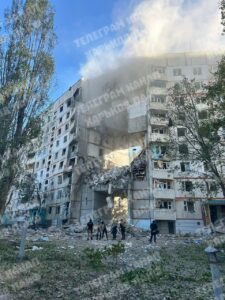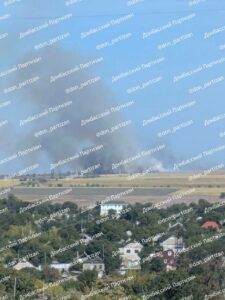On the night of September 24, Russian forces launched new wave of strikes in Ukrainian rear regions. Explosions thundered throughout the country. Kiev failed to hide the damage.
The Armed Forces of the Russian Federation used the wide range of weapons for strikes on various targets in Ukraine, including drones, missiles and upgraded heavy bombs.
Russian strikes were recorder in the Kiev region. Explosions thundered in the areas of the town of Bila Tserkva and Borispil airfield used by the Ukrainian military.
At least three explosions thundered in the city of Poltava and its region. The local Kamishnya 110 energy substation was heavily damaged.
Two Russian Kh-59/69 missiles struck Ukrainian positions near the town of Bobrik in the Chernihiv region. According to local reports, S-4D radar was destroyed and IRIS-T anti-aircraft missile system was damaged.
More Russian strikes were reported in the Vinnitsa and Cherkassy regions.
Russian aircraft are pounding Ukrainian military reserves accumulated in the war-torn regions. Russian strikes do not stop in the Kharkiv region. Last night, the local authorities confirmed at least two strikes in the city limits. According to Ukrainian mayor, Russian forces allegedly struck the forest area on the outskirts of the city; but local residents reported that a command post and a training camp of the Armed Forces of Ukraine were deployed in the forest.
When trying to repel the attack on the industrial zone in Kharkiv, the Ukrainian air defense deployed in the city has traditionally struck a high-rise apartment building with an anti-aircraft missile, destroying several apartments. Three people were reportedly killed and 24 others were reportedly wounded.
A series of strikes destroyed targets in the city of Sumy and its region, which reportedly included Ukrainian air defense system, military warehouse and areas of deployment of the Ukrainian military near Russian border. The local Shostka 330 energy substation also came under Russian attack.
The upgraded FAB heavy aerial bombs destroy targets in Ukrainian rear areas, including in the cities of Kharkiv, Sumy. Zaporozhie has recently joined this list. LINK
On the night of September 24, Zaporozhie came under Russian attack for the second night in a row. According to local reports supported by footage, Russian Iskander missiles struck one of the largest Ukrainian plants Motor-Sich. As a result of the precision strikes, workshops used for the production of components for drones and aircraft were destroyed. Losses were reported.
The Russian Ministry of Defense confirmed that the Armed Forces of the Russian Federation struck the enterprise of the Defense Industry of Ukraine, where aviation gas turbine engines for combat aircraft of the Armed Forces of Ukraine were produced and serviced.
Russian forces also reportedly struck an energy facility and a railway depot in Zaporozhie, where another military echelon with manpower and equipment could be destroyed. Any details and result of the attack are yet to be revealed.
Another Russian precision strike was reported in the town of Kramatorsk in the afternoon of September 23. Several explosions thundered in the northern part of the town. According to local monitoring sources, Ukrainian S-300 air defense system was destroyed by Russian Tornado-S MLRS. Two launchers of the air defense system were heavily damaged, as well as the command post and the radar. Nine Ukrainian servicemen were reportedly killed in the attack. A large fire broke out in the area.
At the same time, at least four Russian heavy aerial bomb upgraded with planning and correction modules reportedly struck the area of the military airfield near Kramatorsk. Ukrainian sources do not reveal the damage.
The efficiency of constant Russian strikes in Ukrainian rear areas both near the front and throughout the country remains high. Ukrainian air defense was depleted during years of war. The Ukrainian military lost a lot of its Soviet-made systems. Meanwhile, its Western patrons supply a limited number of NATO-type air defense systems, which are not particularly effective against Russian missiles and drones, but their operation and repair add troubles on the battlefield.
In its turn, Russia is increasing the pace of production of various weapons of destruction, and improves their effectiveness. So the FAB heavy bombs, which have long been a nightmare for Ukrainian soldiers, are now reaching their targets in Zaporozhye.









russia’s obsession with protecting its enemies is staggering. in medieval wars, peasants were the primary target because peasants created wealth for their lords, so all enemy villages were burned down and all civilians murdered. if you’re wondering how the u.s. protects civilians, we had a very nice example during the war in the former yugoslavia, when they bombed serb civilians in factories during the day and in residential areas at night. serbs never did any harm to the u.s. to be said.
yet former czech president vaclav havel dubbed it a “humanitarian” bombing. as a result, russia has lost all the former eastern bloc and buffer zones, because everyone understands that russia is weak and cowardly and the us. are ruthless and dangerous. and this is perfectly why russia is now fighting proxy war against the us in kursk instead of california. being coward and weak has it’s price.
and what really baffles me is how putin can hope that the west will recognize the right of russians to exist, or how can he hope that the west will fear russia’s nuclear detterent when he can’t even deal with the puppet regimes of poroshenko/zelensky and still call nato countries “partners.” a thousand, a million times we have told him that they are his mortal enemies, but he never learned anything.
no one reads what you write.
oh, people do. don’t be fooled. russian propaganda is worthless. and putin will soon have to solve his dilemma. to start a real fight against his “partners” in nato, which will inevitably lead to world war 3 and he will lose control of power in the kremlin and probably his miserable life as a result, or he will be ousted by the real opposition of his generals, who are really fed up with lavrov’s “agreements” and “deals” and confusing and contradictory orders from moscow.
and if not generals, the ordinary people will do that as nobody wants to be conscripted to the army which barely fights back, wandering without clear command, mostly circling in their own minefields with the hands tied behind their back. the brave russian air force even didn’t dared to shot down a single u.s. drone, they are dumping fuel on them instead. what a “superpower” russia is.
i don’t read what you write,pi, point.
wrong some times he’s worth the time whereas you’re a waste of time – irrelevant!
nazis cant even operate nazi-aligned-terrorist-organization “air defence” installations.
heheheh
gurki only interested in mulatto semen
usa is going to either bring poohtin to justice or…bring justice to him…
if you live in moscow get out asap…
heheheh
i forgot to mention, i have a ladyboner for ramses, she is such a cutie!
heheheh